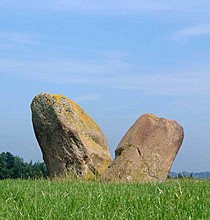|
|
|
|
Clifton Standing StonesStanding Stones
|
||||||||||||||||||||||||
|
|
|
Images (click to view fullsize) |
|











|
Fieldnotes |
|
|
There's space to park a car just on the other side of the A6, by Mount Clifton farm. The follow Tinklers Lane, over the M6. Not a long walk, easy going, gates not stiles. I think these would be OK(ish) in terms of disabled access, though the track is a little rutted in parts. I couldn't help wonder if the larger stones is related to the pink granite of Shap. |
 Posted by Hob
Posted by Hob20th August 2004ce |
|
To elaborate on Fitzcoraldo's comment that "There is one large stone that may be earthfast and a number of other stones"... at this second collection of stones that are seemingly in alignment with the standing stones, beside the large elongated stone layn in the ground, one of those other stones, though small, much smaller than the other stnding stones, is actually steadfast in the ground and standing. Also, the OS map associates 'The Hag' with something in this area, though I can't tell what. |
Posted by FlopsyPete 13th October 2003ce Edited 14th October 2003ce |
|
Clifton is the next vilage along from Eamont Bridge on the A6 south. We tried to access the stones via the footpath at Mount Clifton but the farmer had not kept the path clear and it would have meant taking two lads through a bunch of agro-industrial stuff. So we used the path from Clifton Hall instead. This turned out to have a bonus because there's a Peel tower that you can have a mooch around. Cross the motorway using the bridge and follow the path south along the side of the motorway. Once you get to the gate you can see the stones a couple of fields away. Just before you walk down the field boundary towards the stones, check out the field clearance in the corner of the field. There is one large stone that may be earthfast and a number of other stones. This clearance is on the same alignment as the two standing stones. The stones themselves are a handsome pair of boulders a big 'un and a little 'un. They are made of a red stone. The smallest stone has been set in concrete. They are aligned NW-SE. There is a nice view of eastern Penrith to the north |
 Posted by fitzcoraldo
Posted by fitzcoraldo23rd June 2003ce Edited 23rd June 2003ce |
Folklore |
|
In the pasture on the eastern bank of the Louther, In the way to Clifton, are several cairns, or carracks, as the Scotch call them, made of dry stones heaped together; also many other monuments of stones, three, four, five set upright together. They are generally by the country people said to be done by Michael Scot, a noted conjuror in their opinion, who was a monk of Holm abbey in Cumberland: they have a notion too that one Turquin, a giant, lived at Brougham castle; and there is a tower there, called Pagan tower; and Sir Lancelo de Lake lived at Mayborough, and flew him. Near Clifton is a famous spring, where the people go annually on May-day to drink, by custom beyond all remembrance: they hold it an earnest of good luck the ensuing year, to be there and drink of the water before sun-rise. This no doubt has been continued from British times, and is a remain of the great quarterly festival of the vernal equinox.William Stukeley, Iter Boreale (northern tour of 1725) p45 |
 Posted by Hob
Posted by Hob15th September 2008ce Edited 15th September 2008ce |
Miscellaneous |
|
|
According to Tom Clare in his excellent new book, Prehistoric Monuments of the Lake District. "in the nineteenth century they were variously referred to as Crummack Stone and Cromlech Stone; the latter suggesting that they were considered to be the remains of a tomb." Prehistoric Monuments of the Lake District by Tom Clare 2007 Tempus Publishing Ltd |
 Posted by fitzcoraldo
Posted by fitzcoraldo28th October 2007ce |
| According to the RSM, the smaller southern stone was re-erected in 1977, when a small, plough damaged cairn was found immediately to the east of the stones. In the central area of the cairn there was found a large amount of burnt bone, interpreted as the remains of several humans. |
 Posted by Hob
Posted by Hob15th October 2004ce |
|
In Burls from "Carnac to Callanish" he mentions a row at Lowther Woodhouse that supposedly led to a cairn near Yanwath Wood and adds 'but this is hearsay without confirmation'. These two stones are 750m from Yanwath Woodhouse and are 300m from Yanwath wood. Is this the row that Burl had heard of? |
 Posted by fitzcoraldo
Posted by fitzcoraldo3rd July 2004ce |

